Risk Register Software
Effectively identify, manage and mitigate risk with our risk register software. Build multiple risk registers, automate the risk assessment process, and use workflows to implement controls and mitigating actions.
Create a risk register
Use our risk register software to create unlimited online searchable risk registers to easily categorize & rate risk and assign ownership.
Conduct risk assessments
Roll out online risk assessment forms using automated workflows to fully automate the risk assessment process – with all risk assessment results feeding into the software.
Implement controls
Build a digital control library to keep risk levels within your risk appetite and link risks to the relevant controls.
Mitigate risk
Implement workflows to escalate and resolve risk – documenting the relevant risk treatment actions.
Risk register software capabilities
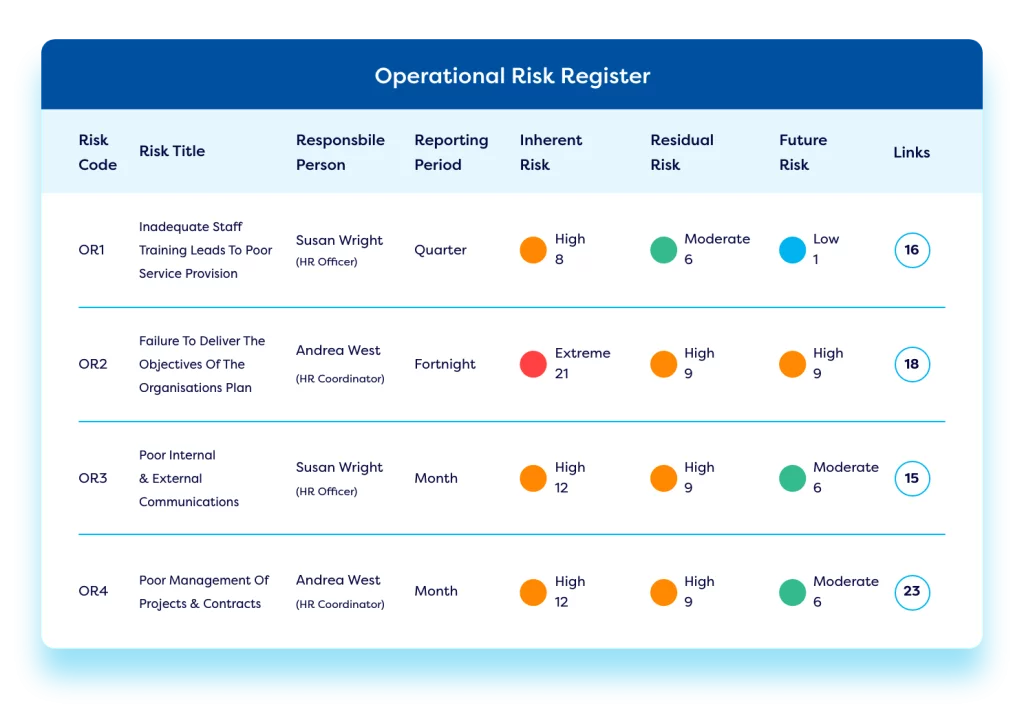
Build a risk register
For best-practice comprehensive risk management, use our risk register software to establish multiple risk registers online using our best-practice frameworks and templates.
Different detailed risk registers can be established for key areas like, operational risk, cyber risk, strategic risk, project risk, and compliance risk.
Firms can categorize and rate risks according to their type and severity and establish ownership, escalation routes, and Key Risk Indicators (KRIs). They can also perform probability assessments & impact evaluations for each risk to determine criticality.
Automate risk assessments
Streamline the risk assessment process by using automated workflows to send out online risk assessment forms – with all data feeding straight into the platform.
Different forms and workflows can be created for different risk types to ensure all relevant data is captured and linked back to the relevant risk.
Regular assessments contribute to ongoing risk monitoring efforts – building a comprehensive overview of risk exposure in your risk register.
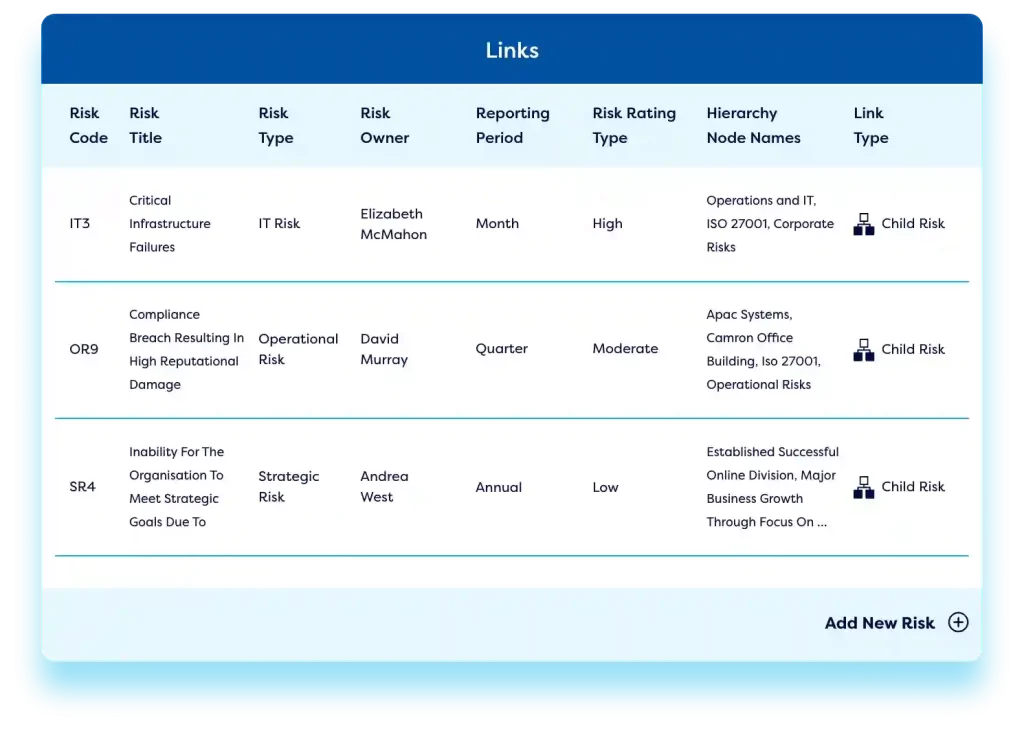
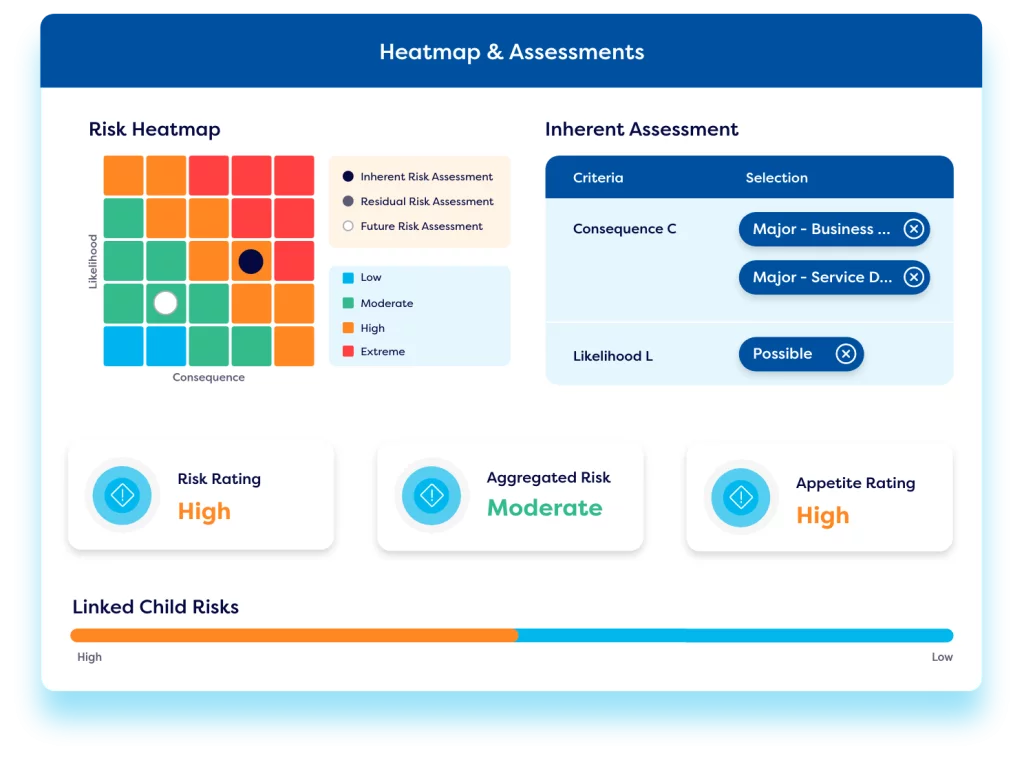
Monitor risk levels
Use our risk register software to easily monitor the risk level and risk exposure for each risk to ensure risk levels remain within your agreed risk appetite.
Firms can use the results of regular risk assessments, questionnaires, and surveys for monitoring risks and risk exposure, they can also use API integrations to pull operational data from other systems & data sources into the platform to monitor risk levels.
Automated alerts are sent when risk reaches an intolerable level to ensure action can be taken.
Maintain a comprehensive control library
Within the risk register software, organizations can utilize a comprehensive framework to establish a control library. The platform enables firms to manage risks and controls in accordance with COSO, ISO 31000, and SOX standards.
Our risk register software enables teams to map risks to relevant controls, providing a clear understanding of risk exposure and the effectiveness of mitigating controls. Teams can also conduct regular control checks and control testing to ensure the controls are effective and functioning as expected.
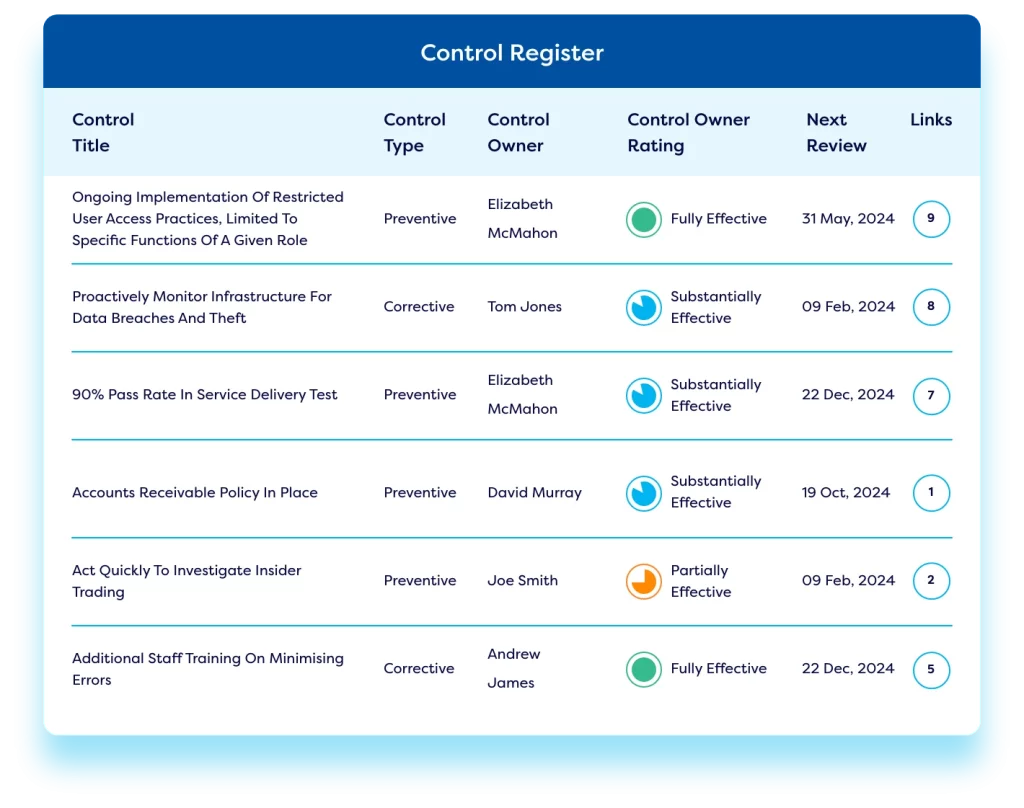
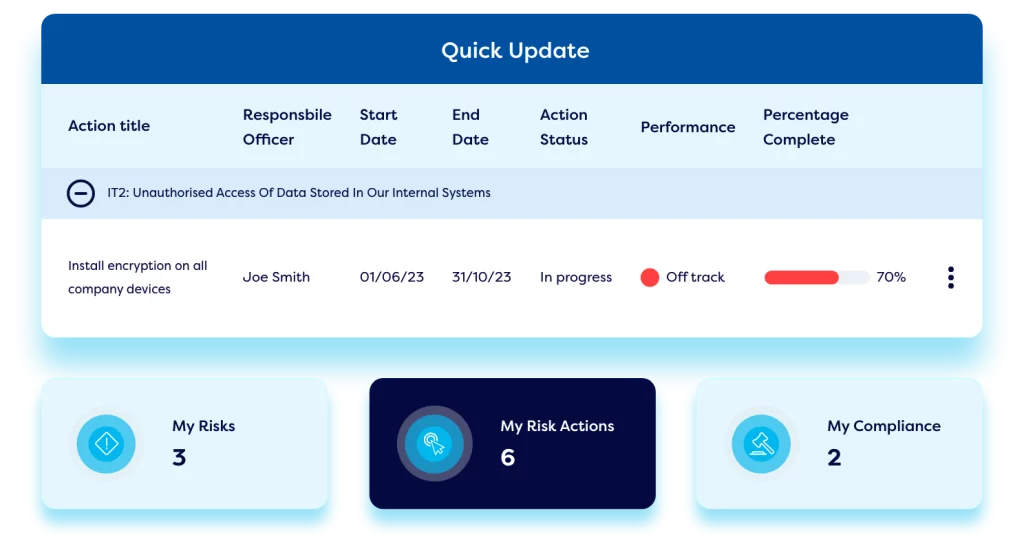
Implement risk treatment plans
The Camms risk register software offers templated customizable workflows to easily build detailed risk treatment plans to log responses taken.
Workflow automation notifies the nominated risk owners and facilitates a step-by-step process to address, respond to, and mitigate risk.
Risk reporting
With our market leading risk management tool, teams can gain insights into their risk profile via a series of dashboards & reports – which can be tailored to each user’s role and responsibilities in managing residual risk.
Board level and executive reporting can be generated at the touch of a button – providing high level insight on risk status and key issues.
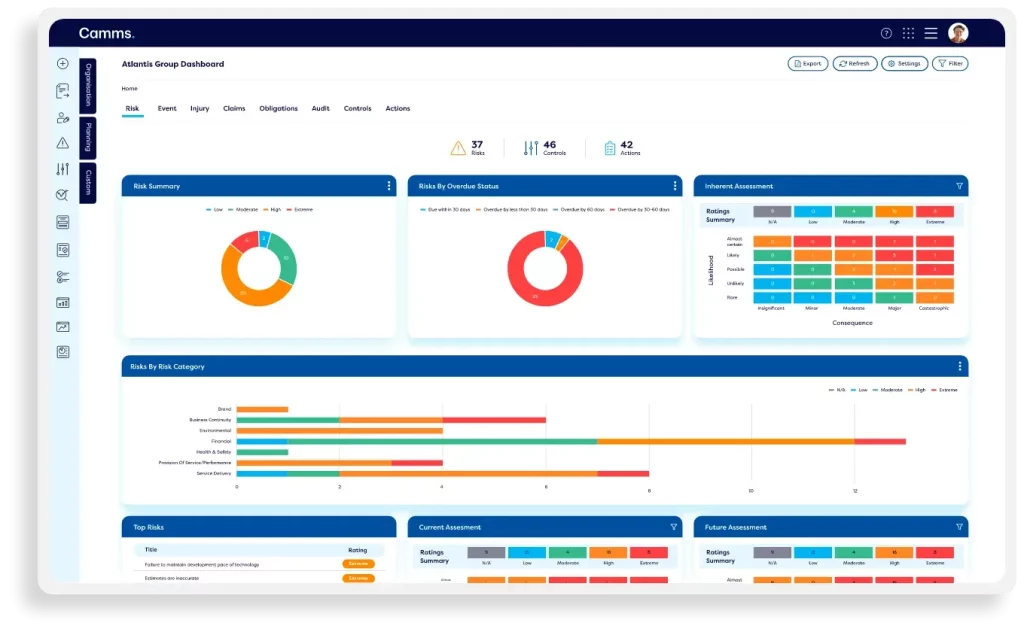
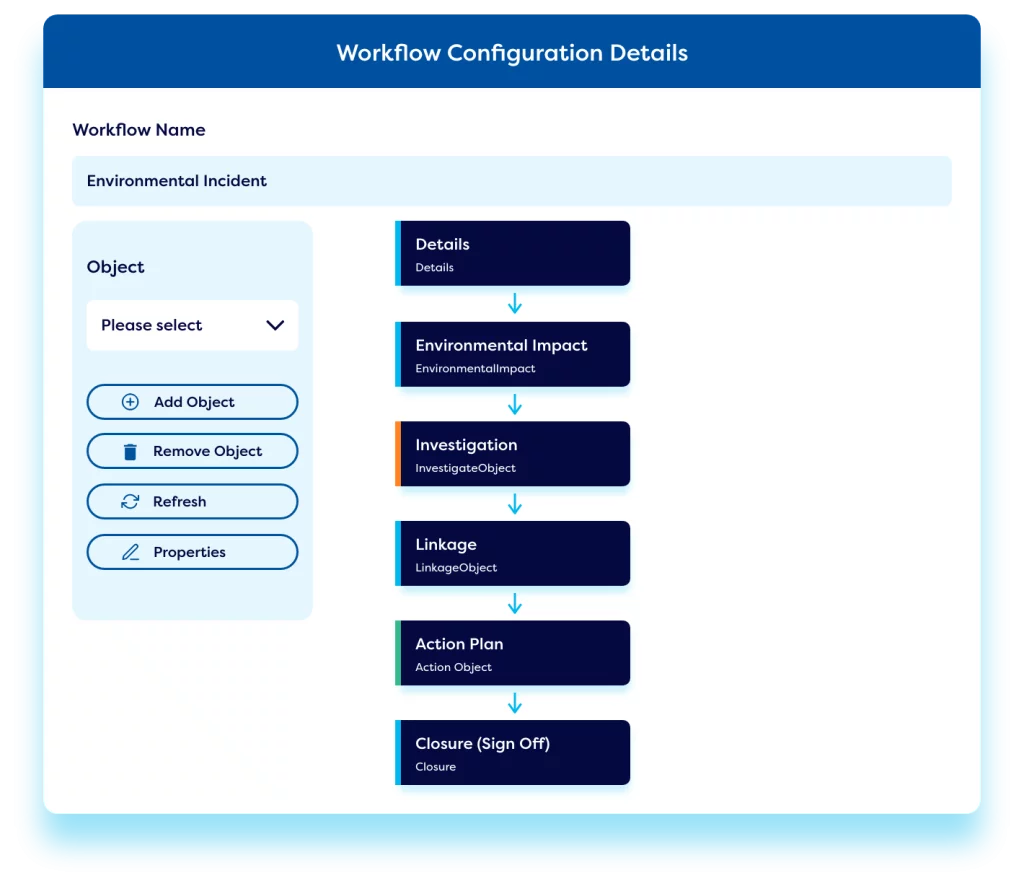
Incident management
Our GRC risk register software also offers best-practice incident management capabilities. Teams can easily log incidents via online forms – capturing critical details and photographic evidence.
Automated workflows escalate the incident based on its category and priority level – notifying the relevant staff. Case management workflows ensure each incident is worked through to resolutions and incidents can be linked to related risks to identify root-causes.
IT & cyber risk management
Firms can also use our risk register software to manage IT and cyber risk for effective cybersecurity risk management.
A separate risk register can be established for cyber risk and a library of corresponding controls and IT policies can also be maintained within the platform.
The solution also facilitates cyber incident reporting and asset management – ensuring cybersecurity remains effective.
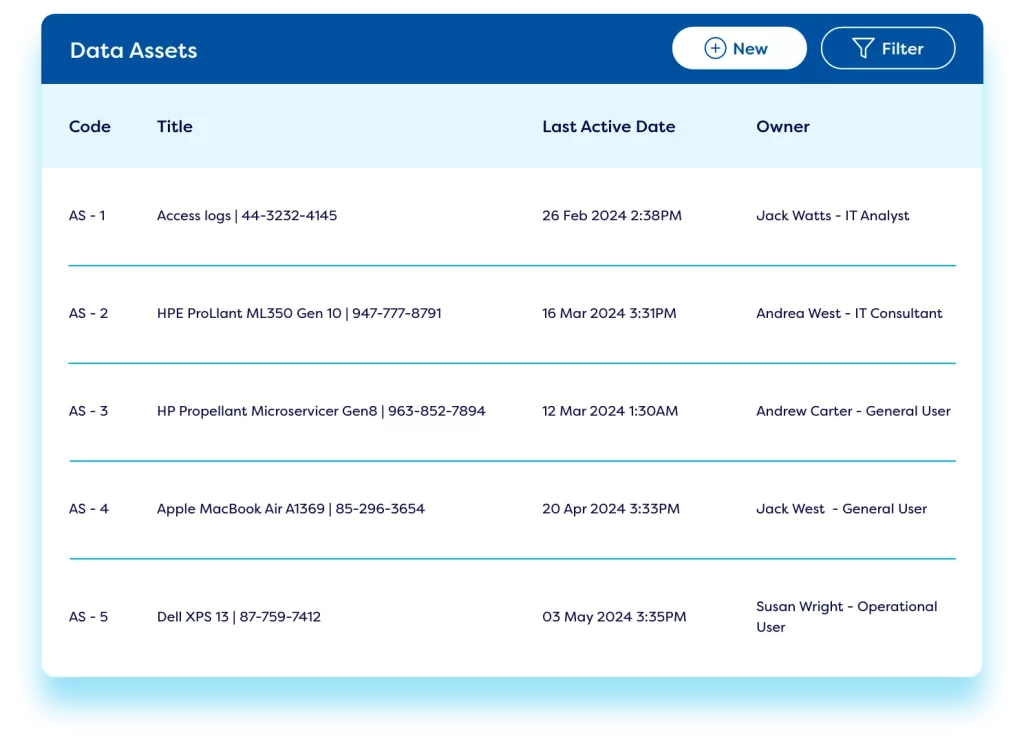
Why choose risk register software from Camms?
Data privacy & security
Our risk register software meets recognized cyber security standards including SOC Type 1&2, ISO 27001, and Cyber Essentials. The Camms platform encompasses role-based audit trails, encryption, and access controls to ensure data privacy compliance and adherence to regulatory requirements.
API integrations
Our risk register software offers robust API integrations, facilitating seamless data flow between various systems and data sources. This allows teams to import risk data directly from spreadsheets and other sources into the tool, ensuring a single, reliable source of truth for risk data.
Discover more about Camms’ Risk Register Software
Resources relating to Risk Register Software
The latest and most relevant pieces of risk register software content to keep you in the loop.

A Simple Guide to Choosing the Right Risk Management Software
Deploying the right Risk Management software, means your organisation is equipped to take the right actions faster but what are the standout qualities of an effective risk management software solution? Find out in this eBook.

8 Surefire Ways to Improve Your Risk Management Program
This whitepaper highlights the importance of adequate risk reporting to guide decision-making, identify risk exposure, and uncover control inefficiencies and explains how to get a complete view of risk across your organisation.
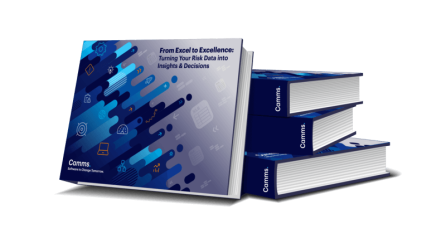
From Excel to Excellence: Turning Your Risk Data into Insights & Decisions
In this eBook, we explore why spreadsheets are outdated for risk management and help you to identify if your business is ready to swap spreadsheets for an automated GRC solution. Plus, we detail the top 10 reasons to switch from spreadsheets to software.
Frequently asked questions about
Risk Register Software
A risk register is a list of potential risks faced by an organization. Risk registers are usually a centralized document or database where all identified risks are recorded and tracked. Risk registers are used in risk management and project management to identify, assess, and manage risks. The risk register helps organizations monitor potential threats to their operations, projects, or strategic objectives, and it provides a structured approach to mitigating those risks. Risk registers capture key details for each risk including descriptions, category, type, likelihood, potential impact, risk owner, plus any controls, mitigating strategies or ‘action plans’ to reduce or control the risk.
A best-practice risk register should include the following information:
- Risk ID.
- Risk title and a description of the risk.
- Risk owner.
- Risk category and type.
- Likelihood and impact.
- Key Risk Indicators (KRIs).
- Risk ratings.
- Risk status.
- Risk assessment results.
- Risk review date.
- Current controls and control status.
- Control test results and control checks.
- Risk score.
- Action plan to address the risk.
Maintaining a risk register involves several key steps to ensure it remains accurate and effective. Teams should regularly review and update the register to reflect new and evolving risks, ensuring all entries are current and relevant. They should engage with stakeholders across the organization to identify emerging risks and validate existing ones through extensive risk assessments and risk data monitoring. Any changes should be documented – including updates to risk descriptions, risk owners, KRIs, risk levels, and mitigation actions. Firms should utilize a standardized format for consistency and ensure that all risk data is captured comprehensively. Teams must periodically analyze the risk register to identify trends that should inform strategic decision-making, ensuring the risk register remains a dynamic tool that supports proactive risk management.
Purpose built risk register software solution is usually an online platform that enables firms to build and maintain an online, digital, searchable risk register. As well as offering out-of-the-box templates and forms to build a comprehensive risk register, risk management software typically offers a whole range of capabilities to enable firms to implement best practice risk management practices. Risk register software platforms usually enable firms to roll out online risk assessment forms via automated workflows – enabling risk assessment results to feed directly into the risk register to understand risk status and monitor risk levels. The platforms also typically offer case management workflows to resolve, escalate, and respond to risk, as well as automated risk reporting & dashboards. The functionality enables companies to identify, assess, prioritize, and manage changes in risk with confidence across all aspects of their operations.
When selecting a risk register software vendor, firms must:
- Consider which staff and teams will be using the tool and what data outputs they need to extract.
- Be sure to address any specific risk-related regulations that you must comply with, which will influence the structure of your risk management program.
- Decide which framework you will use to rate and categorize the risks in your risk register software.
- Ask if the integrated risk register software can be customized to meet bespoke company requirements regarding processes and terminology.
- Does the risk register software offer additional functionality to support growth as your organization expands to meet its broader GRC needs?
- What information security and data protection measures does the risk register software have in place?
- Does the risk register software integrate with your other systems and data sources via API integrations to ensure a single source of truth for risk data?
- Who needs to access the risk register platform, and what data will they input?
- What data does the organization need to view and report on from the GRC risk register software and can it be easily extracted in the desired format?
The benefits of using risk register software include:
- Risk register software provides a centralized platform for all employees to contribute to the risk management program and perform risk-related tasks and actions – generating invaluable insights for risk teams and the board.
- Less time is spent on risk management reporting and administrative tasks, allowing more time for risk mitigation and corrective actions.
- Risk register software provides a holistic view of risk across the entire organization via a variety of dashboards & reports.
- Risk register software platforms enable employees across the entire enterprise to contribute to the risk management process as part of daily operations, creating comprehensive risk data to support data-driven decision-making.
- Risk register platforms offer better visibility into an organization’s risk profile, providing a consolidated view of exposure for your Risk Manager in an online risk log.
- Using risk register software results in a reduction in risk monitoring and reporting costs – ensuring effective risk management.
- A risk management system enhances an organization’s risk management approach by linking risk management to controls, strategic objectives, and enterprise performance.
- Risk register software fosters a risk-aware culture as all employees can feed into the risk management program through simple tasks like risk assessments, questionnaires, surveys, and checks. This data provides a complete picture of risk exposure for leadership teams.
- By using risk register software, firms can align their risk management approach with their organizational strategy – enabling them to take calculated risks that support achieving strategic goals.
- Risk register software supports organizations in identifying, scoring, and managing risks to improve mitigation strategies and drive informed decision-making based on business risk analysis.
- Risk register software can also support with project risk management as it can function as a project management tool – identifying setbacks, tracking risks, and providing mitigation measures. Project Managers can typically use the software to create a project risk register for each live project.
- Choose risk register software that offers a risk register template and risk assessment forms that are easily configurable in-house to eliminate expensive external configuration costs.
- Opt for risk register software that can accommodate multiple risk registers, types, and categories for a comprehensive risk management approach.
- Select risk register software that offers instant reports and live dashboards, that are customizable to suit any internal bespoke requirements.
- Choose a risk register software solution that integrates with your other systems via APIs to ensure a single source of truth for your risk data.
- Look for reliable risk register software that also offers other GRC functionalities like governance, compliance, incident reporting, and ESG, enabling efficient management of these functions in a single platform.
- Find risk register software that includes third-party risk management and vendor risk management capabilities – allowing suppliers to conduct vendor risk assessments online via an external portal. Internal risk teams can then build vendor profiles, scorecards, and formalize the onboarding and offboarding processes.
- Select risk register software that offers cyber risk management and cybersecurity incident reporting to capture the digital aspects of risk management and address cyber risk.
- Choose top risk register software platforms with great customer reviews on G2 and high ratings from Forrester analysts.
- The best risk register software solutions are cloud-based SaaS platforms that can be accessed online, ensuring clients always have access to new releases and features introduced by the risk register software platform
- Look for risk register software that facilitates the mapping of risks to control registers, incidents, and risk treatment actions.
- Look for risk register software that allows assigning ownership levels – ensuring accountability for risk and risk treatment actions.
- Look for risk register platforms that automate generating risk reports to save valuable time – leaving risk professionals with more time to focus on risk mitigation strategies.
- Look for risk register software that offers personalized dashboards with action lists, security layers, permissions restrictions, automated alerts, and document library integration – this allows staff of all levels to action risk related tasks in the tool without being overwhelmed by too much data.
- If you have a lot of project risk to manage, look for risk register software solutions that enable project-controls professionals to monitor project risks, identify opportunities, conduct cost-benefit analyses, and utilize qualitative and quantitative risk assessment tools with real-time dashboards and configurable support features.
- Without risk register software, risk management data is often housed in spreadsheets, but the lack of data governance rules results in poor quality siloed data and a substandard risk management plan.
- Managing risk data across various forms, spreadsheets, emails, and databases leads to inaccuracies and data entry errors.
- Without using risk register software, organizations end up with disparate risk data in multiple spreadsheets, creating separate risk data files and an inconsistent risk framework – resulting in inaccurate risk reporting outputs.
- Relying on manual, unautomated processes slows down the risk escalation and remediation process – affecting risk response times.
- A lack of integration between data sources makes it difficult to link risks to the most relevant controls in the control library.
- Organizations not using top risk register software struggle to compare risks across different sites, departments, and countries due to disparate data and inconsistent risk frameworks.
- Firms not using SaaS web-based risk register software platforms miss out on regular patch updates and releases from the software vendor, meaning the platform could become outdated or lack the latest functionality.
Access our online calculator tool to discover potential savings in cost and hours spent on managing risks by switching to risk register software. Simply provide details about how you currently manage risk in your organization, and our ROI calculator will give high-level estimates on the time and money you could save by implementing an enterprise risk register software tool.
Try out our Risk Register Software ROI Calculator
To get started simply request a demo of our risk register software
Fill out the form below to see the Camms’ enterprise risk register software in action.
